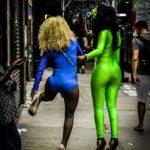




















featured gallery for July 2015
Summer Streets
For this web gallery I've selected artworks that showcase the street as a place of desire and possibility. Poring through the incredible works in the Visual AIDS Artist+ Registry, I was moved by images that draw connections between sexual outlaws and urban life, in the spirit of Samuel R. Delany's Times Square Red, Times Square Blue (1999) and Sarah Schulman's Gentrification of the Mind (2012). It is no coincidence that New York and San Francisco are particularly well represented here. These cities have held, historically if not today, public spaces in which to cruise, play, fuck, create, rally, protest, hangout, earn, heal, reinvent or disappear. Rapid gentrification and “moral cleanup” have transformed these cities once known for their legendary perversion into tourism hubs and overpriced housing markets. Our queer histories and cultures have shifted with this transformation in cities, from a post-Sixties culture of bathhouses and red light districts that celebrated public sex to a narrowing of LGBTQ activism, by some, into national campaigns for marriage equality and appeals for sameness ("we are just like you!"). Of course, the arrival of HIV/AIDS in the LGBTQ community played a huge part in the shifting of sexual cultures, public identities, and political platforms.
I curated this gallery in the way I did because I want to honor (at the risk of romanticizing) our sexual difference, rather than defang and sanitize it. These images span the past forty years and reaffirm the very premise of sexual liberation that we commemorate each June with Pride events: that the first pride was an intersectional riot, and that queer sex is inextricable from politics, precariousness, and perversion. These images suggest urban streets as sites of potential and of refuge, as gathering places for people looking to meet and to celebrate like-minded others. To many, homelessness and/or chosen family are familiar parts of queer existence. My intent here is not to glamorize some experiences at the expense of others. We are a vast community with many moving parts who have experienced great loss and great triumph, and public space has historically been an integral part of that.
This web gallery includes intentional portraiture, documentary photography, paintings and mixed media pieces. Many use the backdrop of the street to amplify the sex appeal or complexity of its subject. For example, Carmine Santaniello’s Untitled (c23) is a 2012 mixed media work that is part of a larger series by the artist depicting tattooed, muscled, beautiful men against walls. A close inspection of the wall behind the anonymous subject reveals scrawled markings including drawings of cock and the text “PASTE MORE / LIVE MORE / EAT MORE / FUCK MORE.” The markings on this figure’s back and the overall constriction of palette fuse the subject with the backdrop, conflating streets, sex, trade, and desire. David Abbott's 1996 painting Dykes on Bikes shows two riders on motorcycle in a parade; the figures' corpulent, sexy bodies seem to merge with the bike, especially the driver. Abbott has rendered the figures as patches of color, highlighting this merge effect with paint in a way that photography could not. Biker and bike merge and the bike is, suitably, fashioned as a queer appendage. Here, the outlaw status of bikers merges with dyke power in a display of radical public sexuality.
I like to think the collective "crowd" created by the subjects in this web gallery constitutes a queer public in which many of us have been in or can imagine being a part of.
Thank you to Sarah Green for your help with this project!
